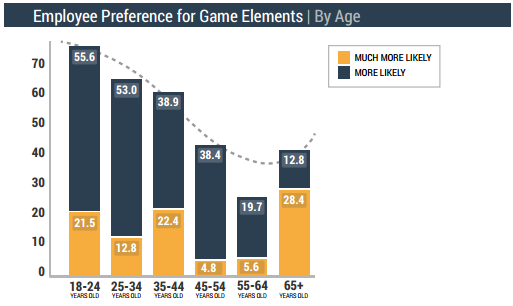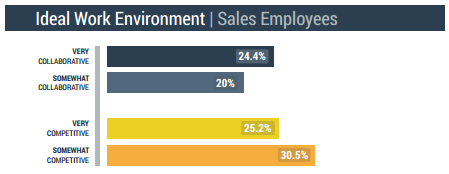 This post originally appeared on the Sales section of Inbound Hub. To read more content like this, subscribe to Sales.
This post originally appeared on the Sales section of Inbound Hub. To read more content like this, subscribe to Sales.

With disengagement among office-based employees at an all-time high, many companies are turning to software for employee engagement programs. When implementing such programs, employers are faced with a choice between a competitive or collaborative approach. We examine here the benefits and drawbacks of these opposing tactics.
As any student of corporate culture will tell you, different employees respond better to different motivation strategies. A typical sales employee may respond better to a competitive program, while a typical customer service employee may engage more with a collaborative one. While all employees usually respond well to perks awarded based on merit, there’s no one-size-fits-all approach to designing or managing an employee engagement program.
Companies across America are having an engagement crisis. In an interview with Forbes, Professor Teresa Amabile of the Harvard Business School discusses the rising trend of workers who self-identify as "disengaged." Contrary to the conventional wisdom that disengagement is only a problem among Millennial workers, Amabile says engagement levels are low “across the entire spectrum of age levels and income levels.”
According to Amabile, while the engagement crisis first became a news item during the aftermath of the 2008 recession, now “it is even worse than it was at the height of the financial crisis,” which she finds “really kind of peculiar.” It makes sense that employees might be disengaged at work when they don’t know whether or not their job is the next one to be cut, or which additional duties they’ll be asked to perform for the same amount of pay. But even as the economy has improved, levels of engagement have remained relatively flat.
Of course, disengagement is less of a problem now that the economy is recovering, right? Wrong, according to Amabile. She says that with high levels of disengagement, even in a good economy, “you are going to see slower revenue growth in the company and actually lower profitability.” Amabile said that “essentially employee engagement drives the bottom line.”
Instead of pointing fingers, companies need to focus on how to reengage their workers. As the economy continues to improve, companies are starting to compete more and more for the scarce number of skilled workers. Hiring a coveted recruit only to have them immediately disengage due to poor corporate culture or other reasons is a costly occurrence that is apparently rising in frequency.
Combatting employee disengagement can be done in a myriad of ways, but according to a recent employee engagement study from TechnologyAdvice, “over 70% of employees felt engagement software would help them perform better at work,” and “over 25% said it would help them stay motivated.” Additionally, over 54% of employees surveyed indicated they’d be more likely to perform a task if it had game elements.
While all employees valued engagement software, and a majority valued game elements, those that self-report their desire for gamified solutions are overwhelmingly in the 18-24 year old age group. Employees aged 24-34 also reported a high preference for gamified work, but acceptance of gamification drops sharply among respondents aged 45-54 and older.
Perhaps there is something to be said that the trend towards gamification in the workplace is heavily influenced by the preferences of Millennials, but enough older generations indicated they may be open to game elements that gamified solutions are becoming more commonplace in firms of all sizes and operating in all industries.

A quick glance at the testimonials pages of popular gamification companies such as Bunchball, GamEffective, Qmerce, and Kudos reveals clients like Oracle, Disney, Johnson & Johnson, Pizza Hut, and Crocs are already employing game elements in their workplaces. But how -- and more importantly, how well -- are these programs being implemented? The trend is towards employing the powerful motivating forces of competition and collaboration.
According to the TechnologyAdvice study, “the choice between collaboration and competition has a different answer depending upon the department.” When workers in general were polled, the preference for collaboration was higher overall, but the results were murky and within the margin for error.

Better insights were gleaned when respondents were analyzed by job function or department. Predictably, nearly 60% of salespeople indicated their preference for a competitive work environment. Over 30% indicated they wanted a “very competitive” work environment. On the other hand, over 60% of customer service employees indicated their preference for a collaborative work environment. When looking at your own company, it’s important to recognize that departments often have different characteristics, and any engagement tactics will need to be tailored accordingly.
Options for engaging employees varied more than their preference for collaborative or competitive solutions. Respondents indicated interest in engagement programs constructed around wellness or fitness initiatives, points-based rewards systems, gamified progress tracking, corporate social networks, and rankings or leaderboards for performance measurement. The best solutions often satisfy both collaborative and competitive team members, and programs can be customized for any use case.


Perhaps the most powerful insight from the study is best embodied by another quote from Professor Amabile: “The power of progress ... actually motivates many employees more than financial rewards.” According to the study, gamified progress tracking “can help employees visualize their progress over the weeks, months, and years they contribute to their job.” These systems help employees “appreciate all that they’ve accomplished.” Amabile calls this phenomenon the Progress Principle.
In short, employee disengagement isn’t a crisis that will go away on its own. The best employers are looking for solutions to the problem, not finger-pointing or denying that the problem even exists. Many are turning to software and game elements, but there is no one-size-fits-all approach. Only through management’s education, awareness, and increased insight into employee motivations can a solution be reliably achieved.
Enjoy this post? To read more content like it, subscribe to Sales.




![How Marketers Collaborate Effectively Across Departments [According to HubSpot Marketing Leaders]](https://blog.hubspot.com/hubfs/collaborate-across-departments.jpg)




